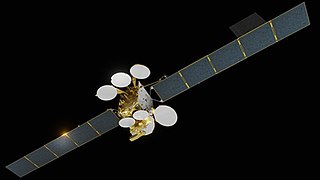The Ku band is the portion of the electromagnetic spectrum in the microwave range of frequencies from 12 to 18 gigahertz (GHz). The symbol is short for "K-under", because it is the lower part of the original NATO K band, which was split into three bands because of the presence of the atmospheric water vapor resonance peak at 22.24 GHz, (1.35 cm) which made the center unusable for long range transmission. In radar applications, it ranges from 12 to 18 GHz according to the formal definition of radar frequency band nomenclature in IEEE Standard 521–2002.

Skynet is a family of military communications satellites, now operated by Babcock International on behalf of the United Kingdom's Ministry of Defence (MoD). They provide strategic and tactical communication services to the branches of the British Armed Forces, the British intelligence agencies, some UK government departments and agencies, and to allied governments. Since 2015 when Skynet coverage was extended eastward, and in conjunction with an Anik G1 satellite module over America, Skynet offers near global coverage.
Türksat is the name of a series of Turkish communications satellites operated or projected by the state-owned Türksat A.Ş.
Türksat 3A is a Turkish communications satellite, operated by Türksat. It was constructed by Thales Alenia Space, based on the Spacebus 4000B2 satellite bus, and was launched by Arianespace atop an Ariane 5ECA launch vehicle, along with the British Skynet 5C satellite, in a dual-payload launch on 12 June 2008 at 22:05:02 GMT, from ELA-3 at the Guiana Space Centre in Kourou, French Guiana.
Türksat 2A, a.k.a. Eurasiasat 1, was a Turkish communications satellite as part of a project to form an instant network with two geosynchronous satellites that is supervised by the companies Türksat A.Ş. in Turkey and Eurasiasat SAM in Monaco.

Intelsat 901 (IS-901) is the first of nine new Intelsat satellites launched in June 2001 at 18° West, providing Ku-band spot beam coverage for Europe and C-band coverage for the Atlantic Ocean region. It is capable of selectable split uplink for Satellite news gathering (SNG), tailored for increased communications demands such as DTH and Internet.
RASAT was an Earth observation satellite designed and developed by TÜBİTAK Space Technologies Research Institute and produced in Turkey to provide high resolution imagery. It was the first remote sensing satellite fully realized in Turkey, and the second indigenously developed remote sensing satellite after BILSAT-1.
Turksat 1B was a Turkish communications satellite as part of a project to form an instant network with two geosynchronous satellites that is supervised by the companies Türksat A.Ş. in Turkey and Aérospatiale of France.
Türksat 1C was a Turkish communications satellite as part of a project to form an instant network with two geosynchronous satellites that is supervised by the companies Türksat A.Ş. in Turkey and Aérospatiale of France.
Türksat 4A is a Turkish communications satellite, operated by Türksat. It was constructed by Mitsubishi Electric (MELCO) of Japan, based on the MELCO DS2000 satellite bus, and was launched by the American-Russian joint-venture company International Launch Services (ILS) atop a Russian Proton-M space launch vehicle on February 14, 2014, at 21:09:03 from Site 81/24 of the Baikonur Cosmodrome in Kazakhstan.

Türksat 4B is a Turkish communications satellite, operated by Türksat.

Türksat 5A, is a Turkish communications satellite, operated by Türksat A.Ş. for commercial and military purposes.
Turkish Space Systems, Integration and Test Centre (USET) is a spacecraft production and testing facility owned by the Ministry of National Defence and operated by Turkish Aerospace Industries (TAI). It is located in Ankara, Turkey. The facility's official inauguration took place on May 21, 2015, in presence of President Recep Tayyip Erdoğan.

Göktürk-3 is a synthetic aperture radar (SAR) Earth observation satellite that will be designed and developed under prime contractorship of Turkish Aerospace Industries (TAI) with support of Military Electronic Industries (ASELSAN) and TÜBİTAK Space Technologies Research Institute for the Turkish Ministry of National Defence.

Es'hail 2 is a Qatari satellite, launched aboard a SpaceX Falcon 9 rocket on November 15, 2018. Es'hail 2 was built by Japan's Mitsubishi Electric company, and operates at 26° East longitude along a geostationary orbit to provide direct-to-home television services in the Middle East and North Africa region. The satellite features 24 Ku-band and 11 Ka-band transponders to provide direct broadcasting services for television, government and commercial content distribution. In addition to commercial services, the payload of Es'hail 2 includes a linear transponder with a bandwidth of 500 kHz and 8 MHz for the amateur radio satellite service, with uplink on 2.4 GHz and downlink on 10.45 GHz.
JCSAT-4 was known as JCSAT-R until it was sold to Intelsat in 2009. It is a geostationary communications satellite designed and manufactured by Hughes on the HS-601 satellite bus. It was originally ordered by JSAT Corporation, which later merged into the SKY Perfect JSAT Group. It has a mixed Ku-band and C-band payload and was used as an on orbit spare.
Intelsat 704 is a geostationary communication satellite that was built by Space Systems/Loral (SSL). It is located in the orbital position of 29.5 degrees east longitude and it is currently in an inclined orbit. The same is owned by Intelsat and after sold to SES World Skies on November 30, 1998. The satellite was based on the LS-1300 platform and its estimated useful life was 15 years.
Intelsat 706 is a geostationary communication satellite that was built by Space Systems/Loral (SSL). It is located in the orbital position of 157 degrees east longitude and it is currently in an inclined orbit. The same is owned by Intelsat. The satellite was based on the LS-1300 platform and its estimated useful life was 15 years.
Türksat 5B is a Turkish geostationary high-throughput (HTS) communications satellite of Türksat A.Ş. developed for military and commercial purposes.
İMECE is an Earth observation satellite designed and developed by TÜBİTAK Space Technologies Research Institute and produced in Türkiye to provide high resolution imagery.





